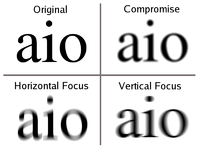
Photo from wikipedia
PURPOSE To compare visual and topographic outcomes 1 year after conventional (C-CXL) vs accelerated corneal cross-linking (A-CXL) in pediatric keratoconus (KC). DESIGN Comparative, retrospective, consecutive case series. METHODS Patients with… Click to show full abstract
PURPOSE To compare visual and topographic outcomes 1 year after conventional (C-CXL) vs accelerated corneal cross-linking (A-CXL) in pediatric keratoconus (KC). DESIGN Comparative, retrospective, consecutive case series. METHODS Patients with topography-confirmed, progressive KC and a corneal thickness of ≥400 μm at the time of surgery were enrolled. Uncorrected (UCVA) and best phoropter-corrected visual acuity (BCVA) and normal maximum keratometry reading (Kmax) were measured at study entry and at the 12-month follow-up. Treatment failure rate was defined as the percentage of eyes with an increase in Kmax of more than 1.0 diopter during follow-up. The adverse event rate was the percentage of eyes with a loss of ≥2 Snellen lines of BCVA from baseline. This was a single-center analysis of 78 eyes of 58 patients that underwent C-CXL (39 eyes) and A-CXL (39 eyes). No eyes were lost to follow-up after 12 months. RESULTS No significant difference between changes in 12 months after as compared to the time before CXL for UCVA (0.01 log MAR; 95% confidence interval -0.14 to 0.15, P = .944), BCVA (0.05 log MAR; 95% confidence interval -0.05 to 0.15, P = .310), and Kmax (-0.77 diopters; 95% confidence interval -2.20 to 0.65, P = .282) between the C-CXL and A-CXL group were observed. Treatment failure rate was observed in 9 of 39 eyes (23.1%) in C-CXL and in 6 of 39 eyes (15.4%) in A-CXL (P = .389). Adverse events were seen only in 1 eye in the C-CXL group. CONCLUSIONS In this retrospective comparison, the accelerated approach was equally as effective as the conventional protocol to treat pediatric keratoconus.
Journal Title: American journal of ophthalmology
Year Published: 2017
Link to full text (if available)
Share on Social Media: Sign Up to like & get
recommendations!